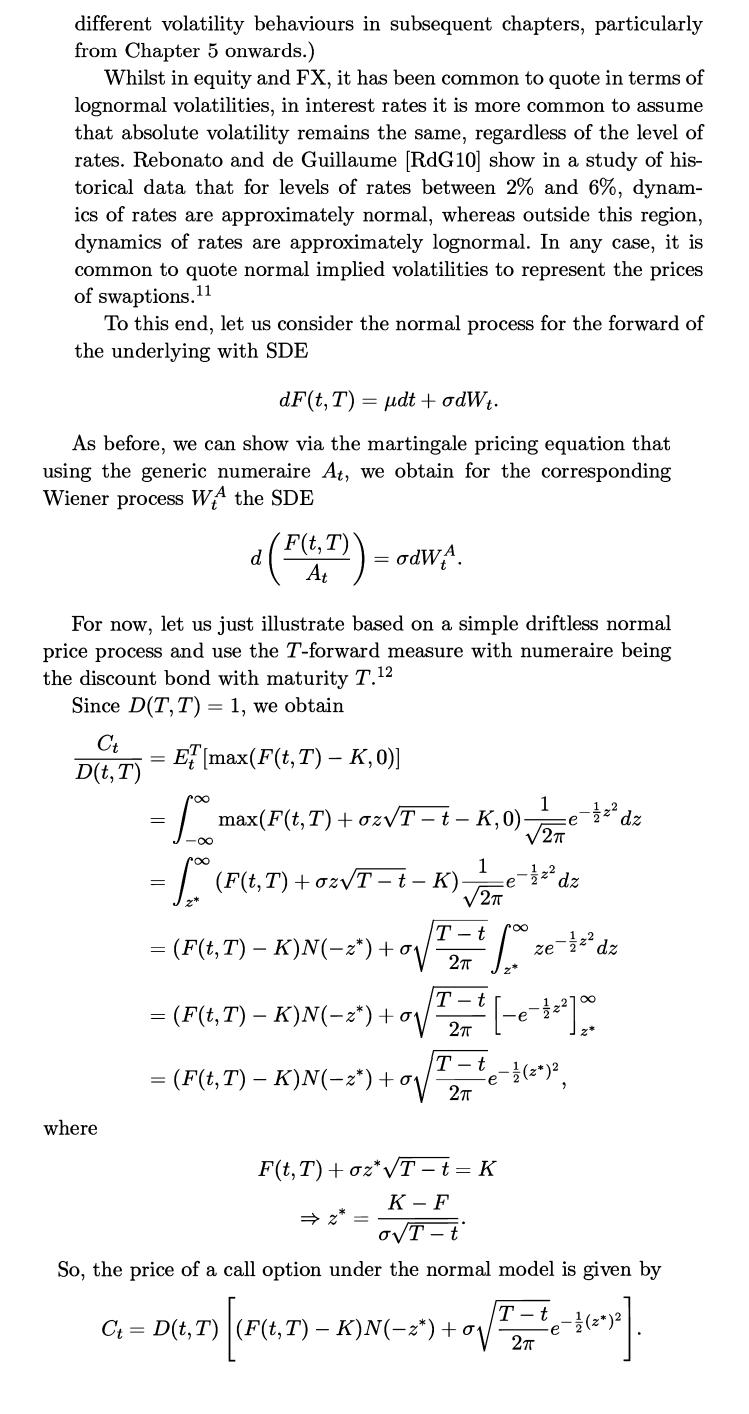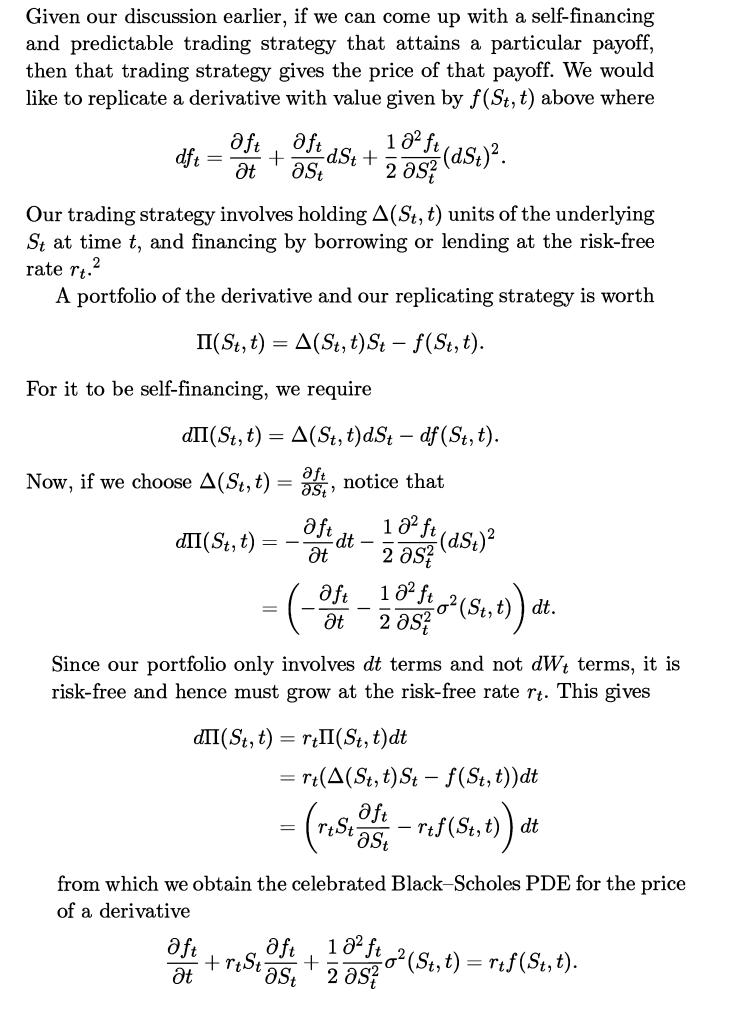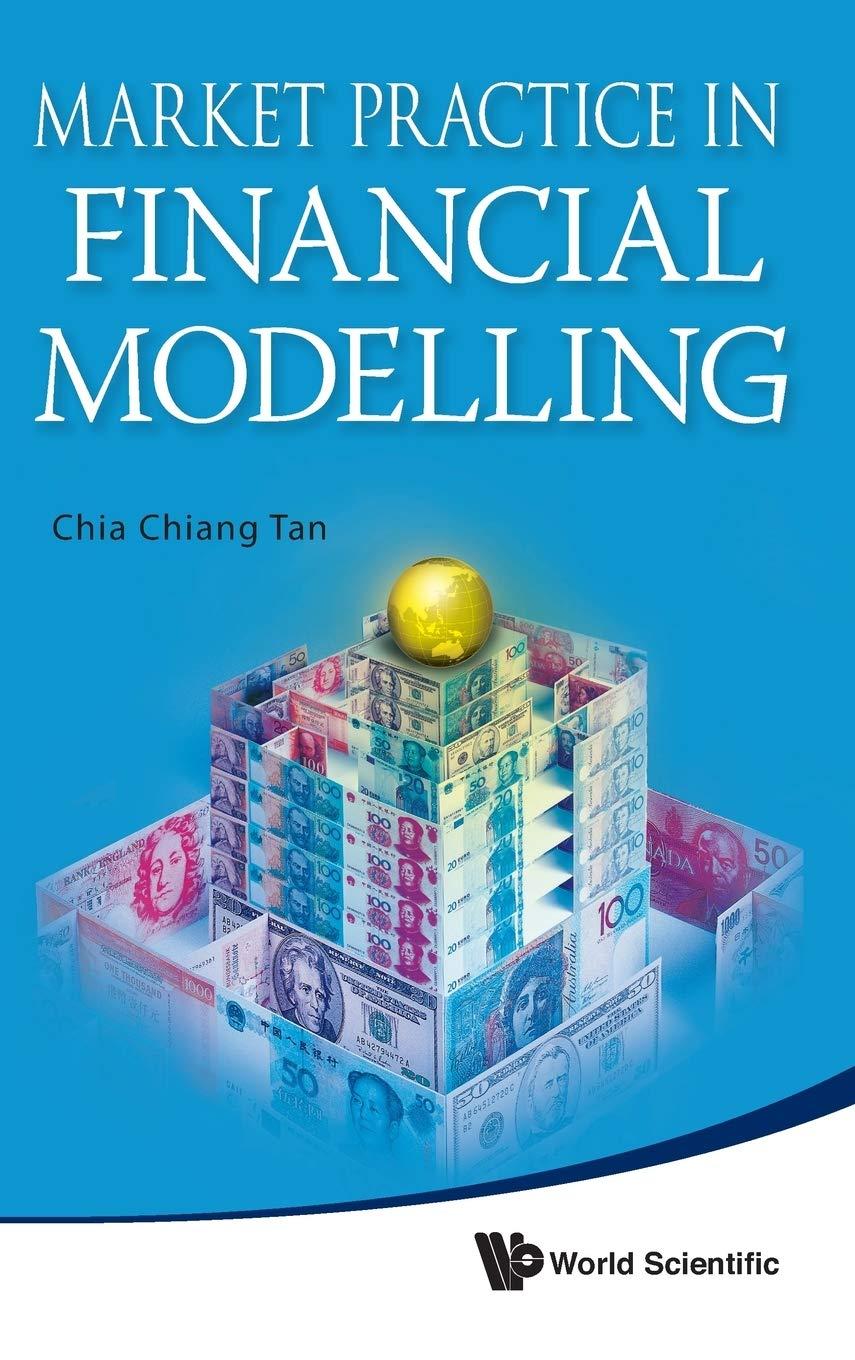Compute the forward delta of a call option based on the normal formula. (The price is given
Question:
Compute the forward delta of a call option based on the normal formula. (The price is given in Section 1.2.4.) Contrast this with the forward delta for an at-the-money (i.e. forward = strike) call option based on the lognormal formula (similar to Question 4 of Chapter 2 but the spot delta is referred to there).
Section 1.2.4.


Question 4
Compute the Black-Scholes delta and gamma for a call-option with payoff max(ST — K,0) at time T.
Section 1.1.2.

Transcribed Image Text:
Section 1.1.2 discussed how hedging leads to the elimination of the random component in the value of a hedged portfolio, and hence the Black-Scholes PDE for the price ft of a derivative Delta Notice that this equation does not have a term based on the 'true' drift (St, t) of the underlying St, i.e. it is irrelevant if we think the underlying is likely to appreciate or depreciate in value. That is what hedging is about. However, the volatility term o(St, t) appears in the equation. This is not entirely surprising, since hedging involves maintaining at all times an amount A(St, t) = 3 of the underlying, this amount 1 0.9 0.8 0.7 0.6 0.5 0.4 0.3 0.2 0.1 0 Ct Bt Implied Vol (%) 50 where changing with St. It follows that the higher the volatility, the more frequent and larger the amount of rebalancing of the portfolio we need. It should be noted that when hedging, we are buying high and selling low. For example, Figure 1.3 shows the delta profile of a Euro- pean call option on a stock below (i.e. an instrument giving one the right to buy the stock at a given strike on the expiry date). The higher the value of the underlying, the greater the value of the option. Hence, to hedge our option, we need to hold a greater amount of the underlying. This means we have to buy more of the stock when its price increases and sell more of the stock when its price decreases. Now, even ignoring transaction costs, and assuming we can trade continuously in size and time, 10 we still need to know when to buy and sell. Suppose we buy if stock increases by an infinitesimal dS and sell when stock drops by the same. Then we will always be buying at S+dS and selling at S-dS. This is guaranteed to cost us money whenever the stock moves. In this way, the value of the option can be seen to be the result of hedging, the cost of which depends on the volatility of the underlying. Let us concern ourselves with the dynamics d where dSt = Stdt + o StdWt. This is a lognormal process for the underlying (i.e. the logarithm of the price of the underlying is normally distributed). For conve- nience, let us suppose we have a constant rate r, then the money market account has value Bt with dBt = r Btdt. Let us take B, as the numeraire, then as per the martingale pric- ing equation, is a martingale under this measure (termed the risk-neutral measure). This means that given the Wiener process WB under the new measure, we have 50 = e where 45 aft t = e 40 35 30 25 + rt St EB 60 X 0.75 = This gives = r, so that dSt = rStdt + SidWP and dlog St (r - 0)dt + odWP (via Ito's Lemma). A call option has payoff CT = max(STK, 0) at time T. This has value = e 1 2 = St St (dSt dBt Bt Bt St Bt = - K = = 0. CT -r(T-t) EB[max (ST - K, 0)] -r(T-t) aft ast fo= St dw. Bt 70 -r(T-t) 1/2 dz 18 ft + o (St, t) = rtf (St, t). 2 ast = e-(T-t) | Ster(T-t) d max = 6 *(7-8) (Se (T-10) (T-1)+0=/T-1 K) - dz -r(T-t) e e 2 2T = e-r(T-t) Ste(-10) (Tt) po ONT + _1__6 #dz 2 Stock Price 80 e Ster 1 -1/2 dz Ct = StN(-z* + oT t) It is more common to write this as = max 0.85 90 and our derivation is along similar looking equation 1 2) [S (T-1) [ / -(2-oT-t) dz - KN(-z*) N(-2)] 2 Ste(0)(T-1)+oz* T-t (-r) :( Ste(-30) (T-1)+0T-1 K,0) and we have used the change of variable y = z oT - t. This gives the celebrated Black-Scholes formula for the price of a call option as :e 2T = e-r(T-t) [Ster(T-t) N(-2*+ oT-t) - KN(-z*)], log 100 St Bt [S(T-0)- dy - KN(-z")] log For completeness, it is worth mentioning that the Black-Scholes for- mula for a put option with payoff PT= max(K - ST, 0) is Pter(T-t) KN(-d + oT- - StN(-d), 1 which we could obtain in the same manner. Whereas we have used deterministic interest rates above, this is not required. If we had stochastic interest rates, it is convenient to work under the T-forward measure, i.e. with the numeraire being the discount bond D(t, T) maturing at time T. This is convenient since at time T, the value of a forward with delivery T is simply the value of the underlying, so that we have CT =max(STK, 0) max(F(T,T) - K, 0) and D(T,T) = 1. This gives via the martingale pricing equation: Ct CT ET D(T,T) D(t, T) ET [max(FT-K, 0)] St dt + o Bt P 110 Ct St N (d) - e-(Tt) KN (d - oT - t), dw B log () + (r + o) (T t) oT-t 1 2T = K (5) - (r - 21/0) (T t) oT-t 0.95 c (F(t,T)e 0(Tt)+ozTt_K,0) = F(t,T)N(z* + oT t) KN(z*), Ct = D(t, T)[F(t, T)N(z* + oT t) KN(z*)]. This explains the earlier remark that to price a vanilla option in equities or FX, it is only the volatility of the forward process that matters. Incidentally, our use of the forward process means we have incorporated equity dividends and the effect of the domestic and foreign rates in our new formulation. e-r(T-t) KN (-z*). It is worth pointing out that whereas the market has long since moved away from a pure lognormal model for equity and FX options, it is common to quote option prices in terms of implied volatilities. This can be seen as an input into a Black box, since a given implied volatility will give a unique price given the rest of the market data (e.g. rates, spot, dividends). After all, the price of a call or put is a monotonic function of implied volatility. There is logic to quoting implied volatilities rather than prices since prices for options of dif- ferent strikes obviously vary a lot more than implied volatilities, so it is easier to visualise an implied volatility surface. Figure 1.4 shows an example of an equity volatility surface. The fact that implied volatilities are different for different strikes suggests that the log- normal model does not adequately capture market dynamics. (We shall explore implied volatility and the models needed to capture (F(RT)) + 21/0 (T t) oT-t the same lines as before, so we get the 1.05 Moneyness = Strike / Spot 1 2 1.15 120 dz 1.25
Fantastic news! We've Found the answer you've been seeking!
Step by Step Answer:
Answer rating: 66% (3 reviews)

Answered By

RESHMA SUJITH
Hi,
I am Reshma Sujith.I have completed my M S C Chemistry and B E d from most reputed colleges in Kerala.Teaching is my passion and I love teaching a lot.I worked as a science teacher for secondary school for almost one year.The experience that I got from there,made my interest in teaching a lot more.I always teach my students by connecting with our daily life,which make my teaching unique and different.My Simple tips and tricks to study the most difficult subject will surely help the children to love chemistry a lot.
0.00
0 Reviews
10+ Question Solved
Related Book For 

Question Posted:
Students also viewed these Business questions
-
Risk reversals and strangles are described in Section 2.3.2 as packages of calls and puts with strikes on either side of the forward. Using the approximation to the SABR formula per Section 6.2.3,...
-
Derive Dupires formula in Section 5.1.2 in terms of put prices rather than call prices. Section 5.1.2, More interesting is the question of how to recover (St, t) to fit all given market prices. Let...
-
Consider the GARCH(1,1) model Ytayt 1+tt, =w+ay - 1+ Bo 1, where + are independent and identically distributed standard normal random vari- ables. Compute the kurtosis of the series {y} and show it...
-
The 2017 financial statements for the Thor and Gunnar companies are summarized below. These two companies are in the same business and in the same province but in different cities. One-half of Thor?s...
-
Show that in the case of an unbalanced disk, the equation derived in Prob. 16.87 is valid only when the mass center G, the geometric center O, and the instantaneous center C happen to lie in a...
-
Gaston Company manufactures furniture. One of its product lines is an economy-line kitchen table. During the last year, Gaston produced and sold 100,000 units for $100 per unit. Sales of the table...
-
How can Charles deal with these issues in a way that is acceptable for both the organization and the employees?
-
Code Churn is a common metric used to measure the efficiency and productivity of software engineers and computer programmers. It?s usually measured as the percentage of a programmer?s code that must...
-
If you were a user of financial statements, what type of ratio/analysis do you think would be most important to use to make sure the company you have invested in is doing well? What would you look...
-
What problems does redundancy cause?
-
What happens when the relationship between two entities is best defined as many-to-many because one record in one entity relates to many records in the other entity and vice versa? For example, at a...
-
Using the data for Problem 16.12 on page 625 concerning the number of stores open for Bed Bath & Beyond from 1997 through 2012 (stored in Bed & Bath). a. Fit a third-order autoregressive model to the...
-
Show how you would go about balancing the following equations: Cu + HNO3 Cu(NO3)2 + NO + H2O HIO3 + Fel2 + HCI FeCl3 + ICI + H2O 2.Conservation of mass A student places 0.58 g of iron and 1.600 g...
-
Sales MOSS COMPANY Income Statement For Year Ended December 31, 2021 Cost of goods sold Gross profit Operating expenses (excluding depreciation) Depreciation expense Income before taxes Income taxes...
-
Prior to the Covid-19 epidemic, Master's and Ph.D. programs in psychology required applying students to submit their scores on the standardized graduate admission exam (GRE). For the past three...
-
Benicio wants to make sure that the Sales table does not contain any duplicate records, which would make any sales analysis incorrect. Identify and remove duplicate records in the Sales table as...
-
University Car Wash purchased new soap dispensing equipment that cost $261,000 including installation. The company estimates that the equipment will have a residual value of $27,000. University Car...
-
a. Use the data given in Table 9-5 (on the textbook's Web site) to develop a multiple regression model to explain daily calorie intake for the 20 countries shown in the table. b. Does this model...
-
An interest bearing promissory note for 90 days at 5.6% p.a. has a face value of $120,000. If the note is discounted 20 days after the issue date at a rate of 6.8% p.a., calculate the amount of...
-
Propose a mechanism for each of the following reactions: a. b. c. d. ,* ,*
-
Identify reagents that can be used to achieve each of the following transformations: a. b. c. d. e. f. Br Br HO,
-
Draw a Lewis structure for each of the following ions; in each case, indicate which atom possesses the formal charge: a. BH 4 b. NH 2 c. C 2 H 5 +
-
The following information is provided by Garden Gears for a new product it recently introduced: Total unit cost $50 Desired ROI per unit $22 Target selling price $72 How much is Garden Gears'...
-
Solid bank loan P5 million to a borrower on January 1, 2018. The terms of the loan require principal payments of P1 million each year for five years plus interest at 8%. The first principal and...
-
3) Assuming annual sales of $250,000 and a 50% gross (contribution) margin, calculate the following a. Average collection period if ending receivables total $45,000 b. Ending days-on-hand of...

Study smarter with the SolutionInn App


